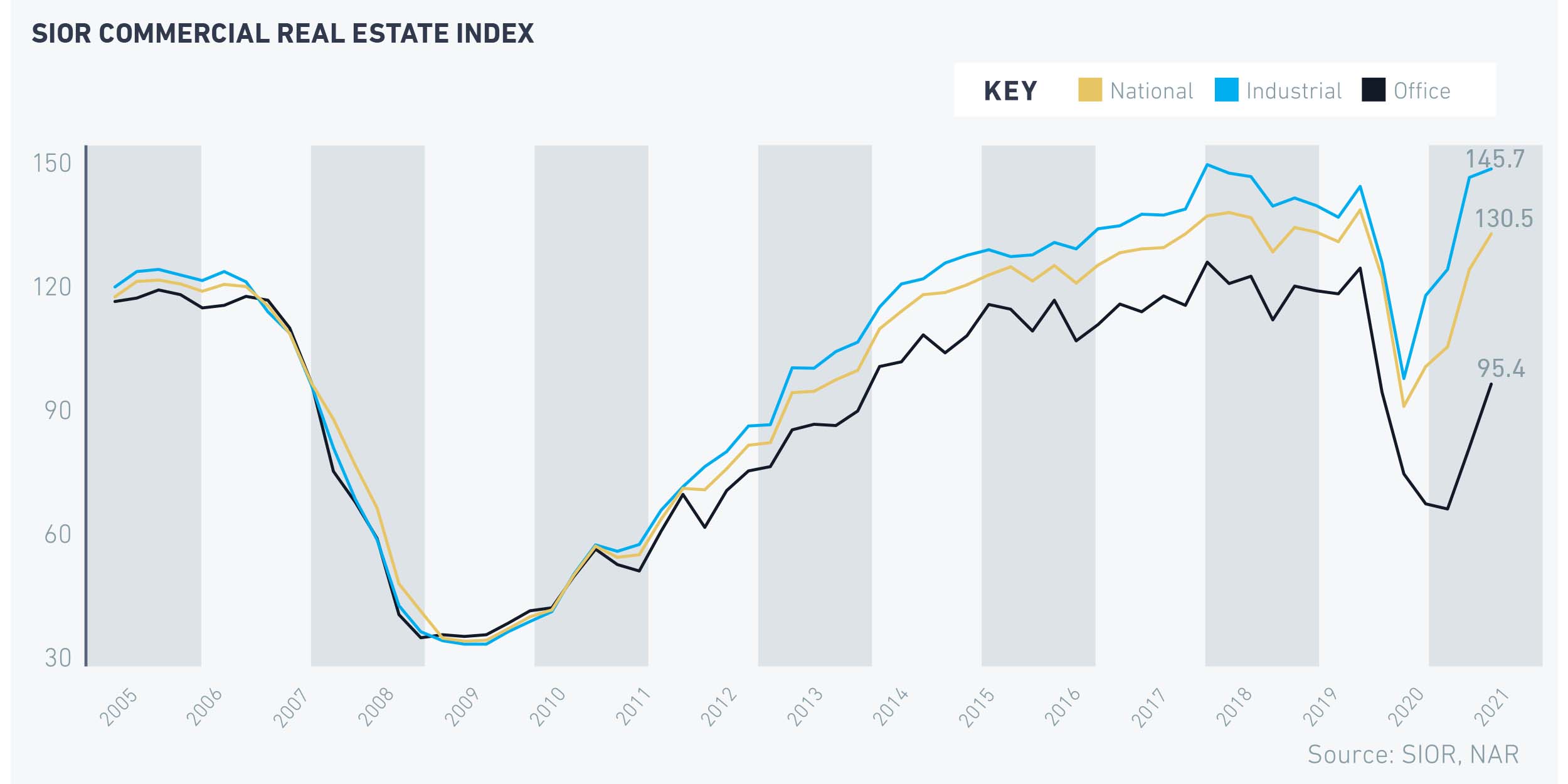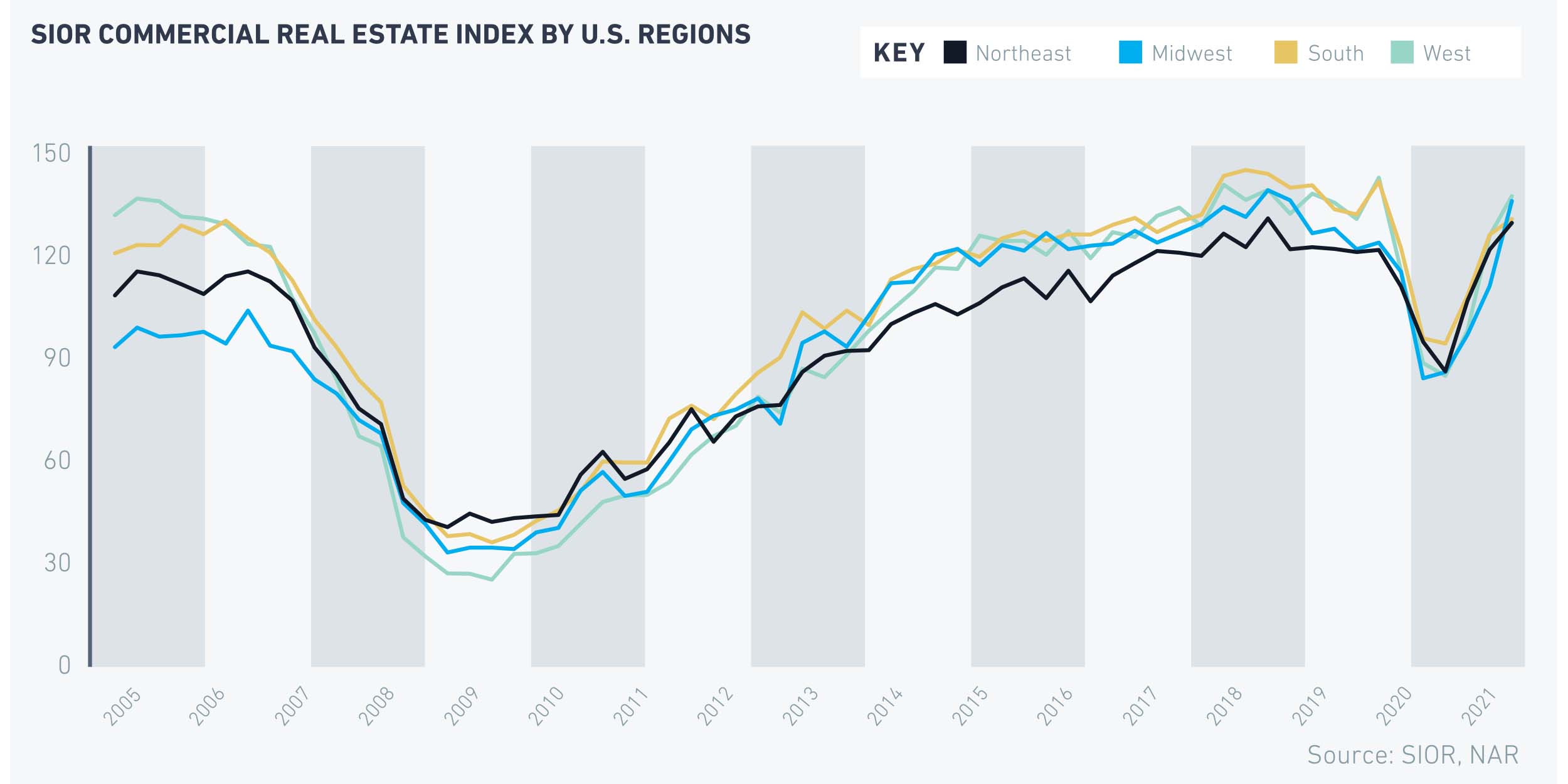This writeup reflects data from U.S.-only respondents. For a report on global conditions, see the SIOR Sentiment Survey at SIOR Sentiment Report.
The office and industrial commercial real estate market conditions continued to improve in the second quarter of 2021, according to SIOR members who participated in SIOR’s quarterly Snapshot Sentiment Report.1In the second quarter of 2021, the SIOR Commercial Real Estate Index rose to 130.5, up 7% from the prior quarter and 45% from one year ago. An index above 100 indicates that market conditions are positive. Industrial real estate market conditions are broadly positive, with the SIOR Industrial Index rising to 145.7, up 12% from the prior quarter and 51% from one year ago. Respondents also reported an improvement in office market conditions, but overall conditions remain negative (index is less than 100). The SIOR Office Index rose to 95.4, up 18% from the prior quarter and 28% from one year ago. Recall that the second quarter of 2020 can be considered the nadir of the pandemic when the economy went into a shutdown, office-using workers were told to work from home, and many retail establishments had to close, so the strong year-over-year growths reflect the normalization of business conditions.
All regional indices (combined office and industrial) rose compared to the prior quarter and registered over 100 (positive conditions). Conditions were strongest in the West (137.6) and Midwest (136.2) regions compared to the South (131.0) and the Northeast (129.9).

Leasing activity continues to pick up, with 73% of respondents reporting that leasing activity across both office and industrial markets increased in the second quarter of 2021, compared to one year ago.
Rents are also rising, with 65% of respondents reporting higher rents compared to one year ago. With improving rental conditions, more than half of respondents at 58% reported that tenant concessions were favorable for landlords.
Respondents reported vacancy rates to be falling, with 62% of the respondents reporting that vacancy rates are lower than one year ago. However, the decline in vacancy rates is likely occurring in the industrial segment because office vacancy rates continue to rise.

A lower share of respondents reported a “glut” in subleasing, down at 26% while 58% reported there is “little” subleasing activity.
A majority of respondents, 73%, have a positive outlook about real estate conditions in their markets in the coming quarter.
Indeed, economic conditions continue to improve. In the second quarter, gross domestic product (GDP) expanded at an annualized2 rate of 6.5%, bolstered by the strong surge in consumer spending for travel and recreation in the wake of a big vaccination rollout and the relaxation of masking and social distancing guidelines pushed. Real GDP ($19.35 trillion) is now running at 2% above the pre-pandemic level in the first quarter of 2020 ($18.9 trillion).
| Key Results of the 2021 Q2 SIOR Survey on Industrial and Office Market Conditions *Reflecting U.S.-only respondents- 73% of respondents reported that leasing activity was higher compared to one year ago (65% in 2021 Q1).
- 65% of respondents reported an increase in asking rents from one year ago (55% in 2021 Q1).
- 62% of respondents reported lower vacancy rates compared to one year ago (51% in 2021 Q1).
- 26% of respondents reported a glut in subleasing availability (35% in 2021 Q1).
- 25% of respondents reported tenant concessions were favorable to tenants (31% in 2021 Q1).
- 56% of respondents reported development conditions are positive (53% in 2021 Q1).
- 49% of respondents reported site acquisition conditions reflect seller’s market characterized by rising prices (65% in 2021 Q1).
- 43% of respondents reported investment pricing conditions are above replacement cost (51% in 2021 Q1).
- 66% of respondents reported local economic conditions have a positive effect on the market’s performance (62% in 2021 Q1).
- 67% of respondents reported national economic conditions have a positive effect on the market’s performance (58% in 2021 Q1).
|
1-159 respondents
2-Annualized rate is the rate of growth if the economy were to continue growing at the current pace for four quarters.